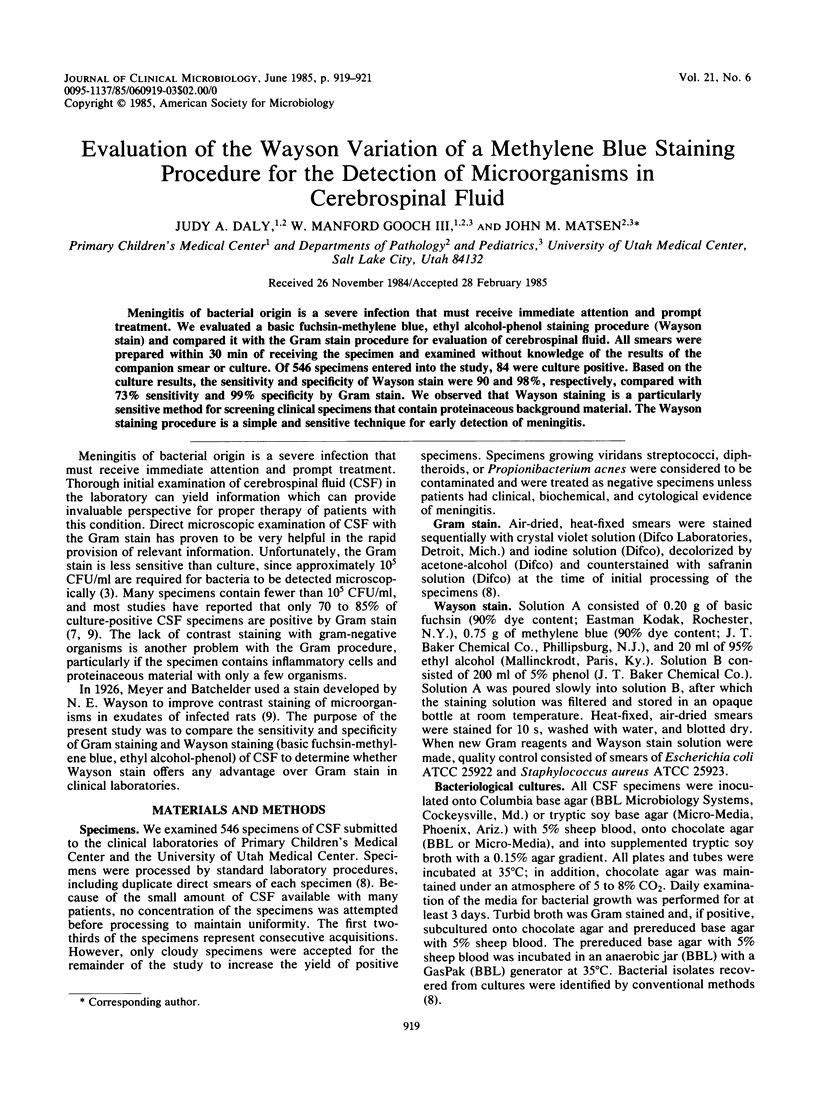Abstract
Meningitis of bacterial origin is a severe infection that must receive immediate attention and prompt treatment. We evaluated a basic fuchsin-methylene blue, ethyl alcohol-phenol staining procedure (Wayson stain) and compared it with the Gram stain procedure for evaluation of cerebrospinal fluid. All smears were prepared within 30 min of receiving the specimen and examined without knowledge of the results of the companion smear or culture. Of 546 specimens entered into the study, 84 were culture positive. Based on the culture results, the sensitivity and specificity of Wayson stain were 90 and 98%, respectively, compared with 73% sensitivity and 99% specificity by Gram stain. We observed that Wayson staining is a particularly sensitive method for screening clinical specimens that contain proteinaceous background material. The Wayson staining procedure is a simple and sensitive technique for early detection of meningitis.
Full text
PDF


Selected References
These references are in PubMed. This may not be the complete list of references from this article.
- Cain A. R., Wiley P. F., Brownell B., Warhurst D. C. Primary amoebic meningoencephalitis. Arch Dis Child. 1981 Feb;56(2):140–143. doi: 10.1136/adc.56.2.140. [DOI] [PMC free article] [PubMed] [Google Scholar]
- Feldman W. E. Relation of concentrations of bacteria and bacterial antigen in cerebrospinal fluid to prognosis in patients with bacterial meningitis. N Engl J Med. 1977 Feb 24;296(8):433–435. doi: 10.1056/NEJM197702242960806. [DOI] [PubMed] [Google Scholar]
- Forsum U., Hallén A. Acridine orange staining of urethral and cervical smears for the diagnosis of gonorrhea. Acta Derm Venereol. 1979;59(3):281–282. [PubMed] [Google Scholar]
- Kronvall G., Myhre E. Differential staining of bacteria in clinical specimens using acridine orange buffered at low pH. Acta Pathol Microbiol Scand B. 1977 Aug;85(4):249–254. doi: 10.1111/j.1699-0463.1977.tb01970.x. [DOI] [PubMed] [Google Scholar]
- Lauer B. A., Reller L. B., Mirrett S. Comparison of acridine orange and Gram stains for detection of microorganisms in cerebrospinal fluid and other clinical specimens. J Clin Microbiol. 1981 Aug;14(2):201–205. doi: 10.1128/jcm.14.2.201-205.1981. [DOI] [PMC free article] [PubMed] [Google Scholar]
- Mirrett S., Lauer B. A., Miller G. A., Reller L. B. Comparison of acridine orange, methylene blue, and Gram stains for blood cultures. J Clin Microbiol. 1982 Apr;15(4):562–566. doi: 10.1128/jcm.15.4.562-566.1982. [DOI] [PMC free article] [PubMed] [Google Scholar]
- Murray P. R., Hampton C. M. Recovery of pathogenic bacteria from cerebrospinal fluid. J Clin Microbiol. 1980 Oct;12(4):554–557. doi: 10.1128/jcm.12.4.554-557.1980. [DOI] [PMC free article] [PubMed] [Google Scholar]
- Shanholtzer C. J., Schaper P. J., Peterson L. R. Concentrated gram stain smears prepared with a cytospin centrifuge. J Clin Microbiol. 1982 Dec;16(6):1052–1056. doi: 10.1128/jcm.16.6.1052-1056.1982. [DOI] [PMC free article] [PubMed] [Google Scholar]
- Smith A. L. Diagnosis of bacterial meningitis. Pediatrics. 1973 Oct;52(4):589–592. [PubMed] [Google Scholar]


